Washington's column
(viewed from N. dome gully)
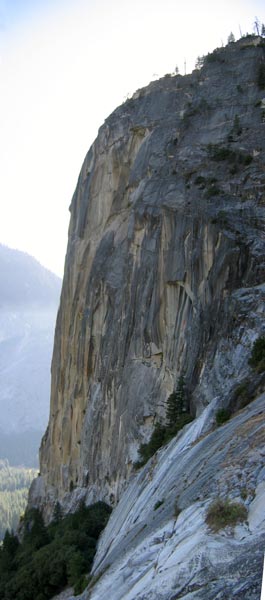 |
The Prow (of Washington's Column)
(Sept 13-15, 2004)
Andy racks gear and models gear sling
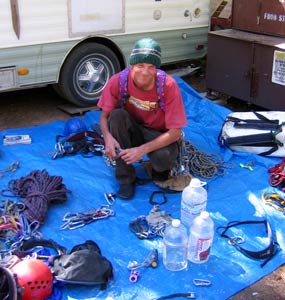 |
There comes a time in every climber's life when for some reason climbing a "big" wall seems like a good idea. I hadn't climbed one in a while, so my resistance was down, and my arguments against it were weak. Andy and I settled on the prow of Washington's Column in Yosemite valley (although the Salathe wall was another possibility, Andy didn't really have the time off). SuperTopo says of the Prow "Spectacularly steep and exposed, with a feel much like the Shield Headwall, the Prow offers a good introduction to moderate aid." 11 pitches of which 7 had some C2 (clean (no hammering) aid climbing harder than C1). How could we go wrong? We planned to head down Monday afternoon, bivy at the base, spend one night on the wall, and be back by wednesday night. That's what happened, so if you were in this just for the suspense, thinking this was some kind of online fanfiction, you might as well stop reading now, but if creaking placements, surprise whippers, autodump portaledges, and other tales of suffering are what you want, read on.
The first order of business was to get our gear together. Since neither of us had done any aid in a while, we had to dig deep to find our stuff. Plenty of things from the normal trad rack were useful - cams, nuts, slings, rope, harness, and carabiners.
But there were the esoteric aid doodads too,
belay 2 (hanging). coached by mr. crab
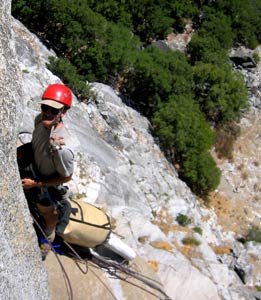 |
aiders (or etriers - webbing ladders to climb up), hooks (metal hooks for sticking on little edges), ascenders (like one way ratchets for the rope), portaledge (a cross between a bed, a hammock, and the rack), wall hauler (a combination pulley and ratchet),
haul bag (an extra beefy extra big vertical tube bag - referred to as "the pig"), and haul line (static (less stretchy) rope). We also had a fly 80's style double gear sling. We had to borrow a few items, and a few more were donated to the cause (thanks Janet, Pat, and Chum). For food we had a combination of MRE parts, tasty bites (highly recommended), bars, and other random odds and ends. we planned on about 3 liters of water each per day, or just over 3 gallons. Throw in some warm clothes, sleeping pad and bag, bivy sack, headlamp... pretty soon the 9,000 or so cubic inches of the pig are filled.
We copied the topos (maps of the route) and headed down to the valley. We unloaded the gear at the Ahwahnee hotel and I drove to the parking lot and took the shuttle bus back. Then the gear went onto our backs and the suffering was underway. I had the pig, Andy had the ropes, rack, and some of the other climbing gear. At first it wasn't so bad. We staggered down the trail until the cutoff for the route. Then it was up the steep climbers "trail" to the base of the column and to a nice almost flat spot under a steep overhang where we spent the night. On the hike in we could see that there were people high on the route, at least 6 pitches up, and a bunch of people on the south face route. So we didn't have to worry about someone getting in our way unless they beat us to the start in the morning or the people up ahead were very very very slow. The route ascends Washington's column just on this side of the skyline on the picture above.
Andy belays pitch 4
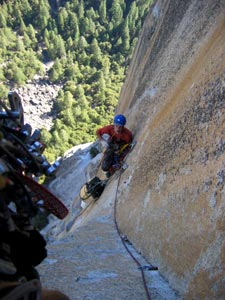 |
cleaning pitch 3
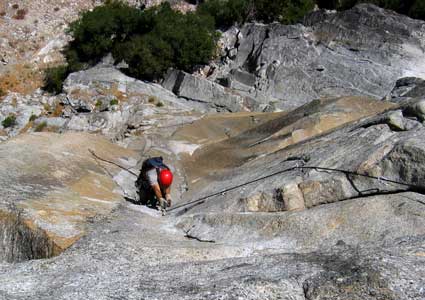 |
The alarm went off the next morning before dawn. We had a quick cold breakfast and repacked for the route. Then we stumbled up the last part of the trail, and up some 3rd and 4th class bits to the base of the route. Andy got the first pitch, and soon he was off. Unless you have your systems dialed, aid climbing is slow, and we did not have our systems dialed. Pitches often take over an hour to lead, for us, even on fairly straightforward aid climbing. It doesn't seem like you are really dawdling, but there are so many steps. Reach up and place a piece (this can require some creativity when there isn't a straightforward placement, or it can be done for you if there is a bolt or other fixed gear). Then you clip in your aider and bounce test the piece a bit to make sure it will hold. Then you climb up onto it, clip the rope in if you so choose, and climb up as high as you can and place the next piece. Sometimes you take the last piece out if you are feeling brave or expect to need it later. If there is no good place, or the next piece is a fixed piece placed by a tall person, your last piece might be down by your knees which can be very strenuous on steep terrain. That is pretty much all there is to aid climbing. Just repeat that until you get to the next anchor, pull up the lead line for the second to jug and clean, and set up the haul system and start hauling the pig. Usually this is done with your body weight. You stand up and slide the ascender up the line, then you sit down on the haul line, with a little (or a lot) of help from your arms or legs get the bag moving, then stand up again. It gets a little old after a few seconds. Meanwhile, the second has clipped his ascenders to the lead line, and is ascending up the line by sliding one, then the other up. When he gets to a piece, he takes it out and continues up. When he gets up to the other person, he gets all the gear and the haul line and hauler, and it is his turn to lead. There are lots of other ways to do this by people who go faster, but that is basically how we did it.
Somehow the first 2 belays I got were hanging belays. That means that I didn't have a nice ledge to sit or stand on, I was just supported by my harness and standing my feet in the aiders. We did have a butt bag, which is a bit like a hammock for your butt, which took a bit of the wait off of the harness straps, but was hardly comfortable. We inched our way up the wall all day. It was a bit hot in the sun, but not too bad, and there was usually a breeze. In the afternoon we were in the shade, and glad that the strong wind was mostly blocked.
Half dome at sunset
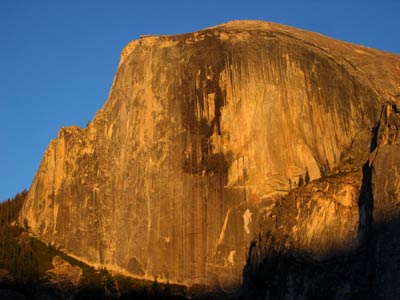 |
going, going ...
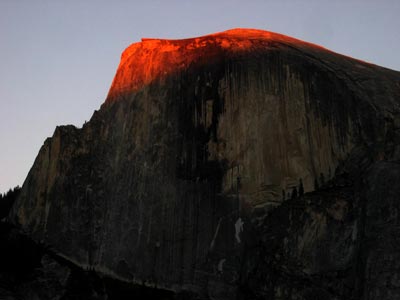 |
At the top of pitch six I had a stretch to place a blind cam into a corner, it seemed fine, but when I weighted it, it decided to pop out and I slid down a steep ramp and over the edge into space. I think I fell 10 to 15 feet total. Andy never even felt me fall (I was nearly at the anchors) and so he was a bit baffled when I yelled down that I was going to "batman" up the rope. Luckily the second placement I got was secure enough and I got to the anchor with no more scrapes. All the way up we had fantastic views of half dome over our right shoulders. I took a lot of pictures, especially at sunset. Speaking of sunset, Andy finished pitch 7 just after sunset. We spent a lot of time messing with the portaledge, but the anchor was about the worst one on the climb, with just a few bolts and some gear over a bend in the wall. This meant that the portaledge hung over the bend and wanted to fold itself around the bend. Andy got nearly dumped out of the ledge while we were trying to get it set up and levelled. Finally I just took the gear and started leading the next pitch by headlamp. Aid climbing by headlamp is sort of weird. You are in your own little bubble of light, and nothing else really exists. Luckily there were no route finding issues, just follow the bolts and the crack. Things got exciting though when one of the fixed pieces was total mank. I tried to fiddle something in, but had no luck. So, it was back to the mank. This was an old bashie that had a pretty frayed cable, and the loop in the cable was busted. So some enterprising (and brave) aid climber had girth hitched a bit of shoelace (maybe a bit stronger, but not much) around the swage on the cable. I got to clip that. Did I mention the cable was rusted and some of the strands were broken?
Good morning Tom
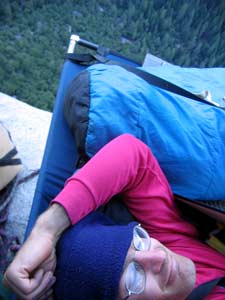 |
Good morning Andy
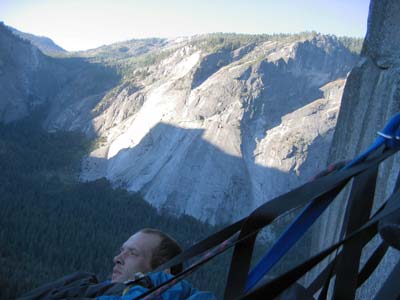 |
Luckily the piece below this seemed solid. I thought light thoughts and eased my weight onto this dubious relic like an overweight wrestler getting onto the scale at a weigh in, and slowly, smoothly, and carefully stepped up and leaned over to clip the next bolt. Unfortunately I was too tired and frazzled to get out my camera and take a picture. Finally I finished this pitch on a small ledge, and fixed the line and started hauling.
It was still a bit of an adventure getting the ledge set up here, but so much easier to have a bit of a rock ledge to stand on as well as a number of bolts spread out horizontally to use as multiple anchors (one for the ledge, one for the pig). Conveniently someone had left a can of deviled ham on the ledge for us, so we gratefully added that to the menu. Then we eased into bed for a somewhat belated and fitful cramped sleep, especially for 6'6" Andy.
Most of the way down the descent
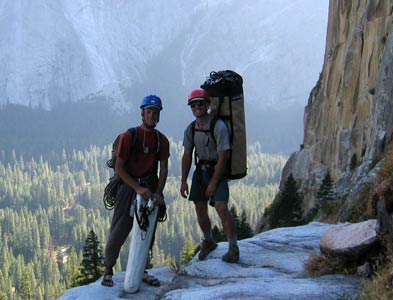 |
The next morning we didn't set any speed records for getting up, but we weren't so very slow either. Then it was on up the wall at our still rather glacial pace. Eventually the angle eased back a bit, and the last two pitches featured at least some free climbing (which goes much faster, but is a pain with all the aid gear strapped on). It was quite windy on top when we got there, so we had to be careful repacking for the descent that nothing blew away. Andy got the heavy small stuff, the portaledge, and the ropes, and I had the pig (at least 24 pounds lighter due to the loss of water). Then it was off to the north dome gully descent. A sort of delicate traverse and downclimb followed by a long hot steep dusty slog followed by a while on a trail. Finally we got to the Ahwahnee and then ran the last bit to catch the shuttle bus back to the truck. There we got some food and a much needed shower before driving back up to Tuolumne.
This little adventure fulfilled our aid climbing requirement for the year, and we were free to go back to free climbing in the sun (at least until it started snowing).
Tired Andy on the descent
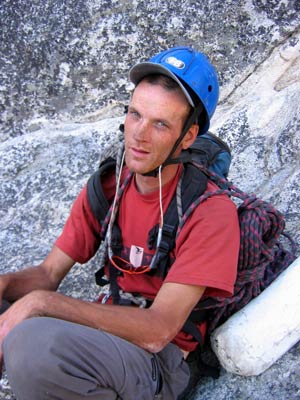 |
Washington's Column from the Southwest
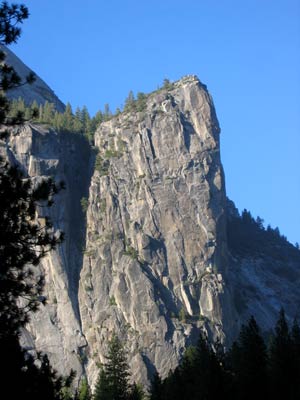 |












